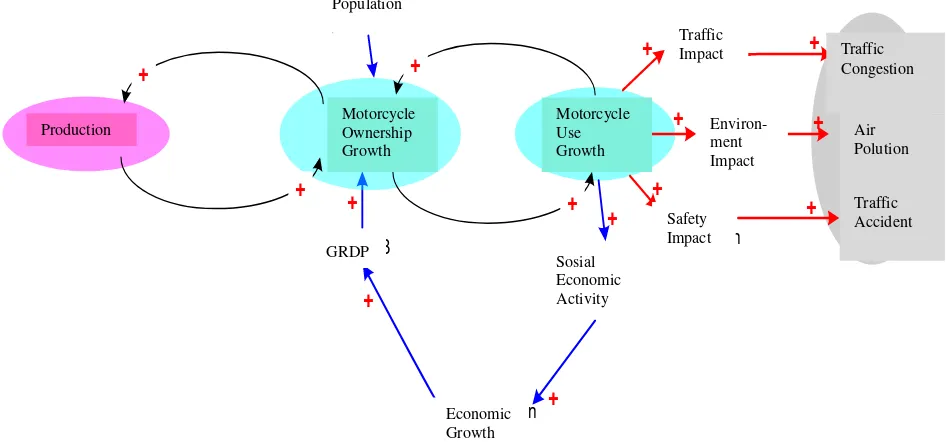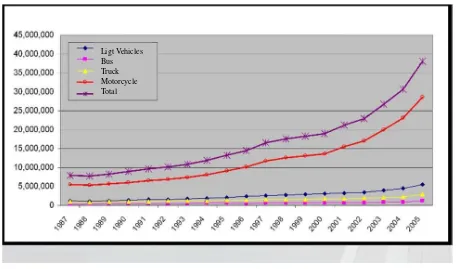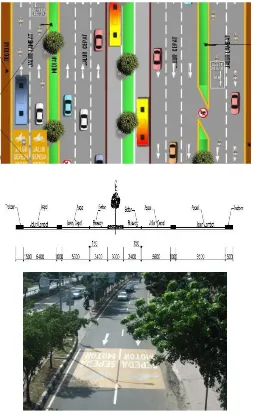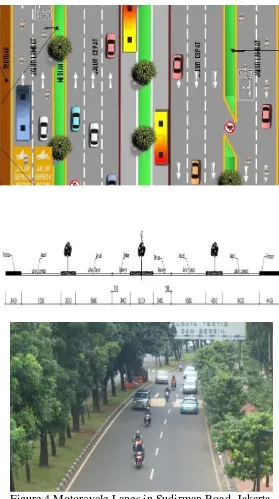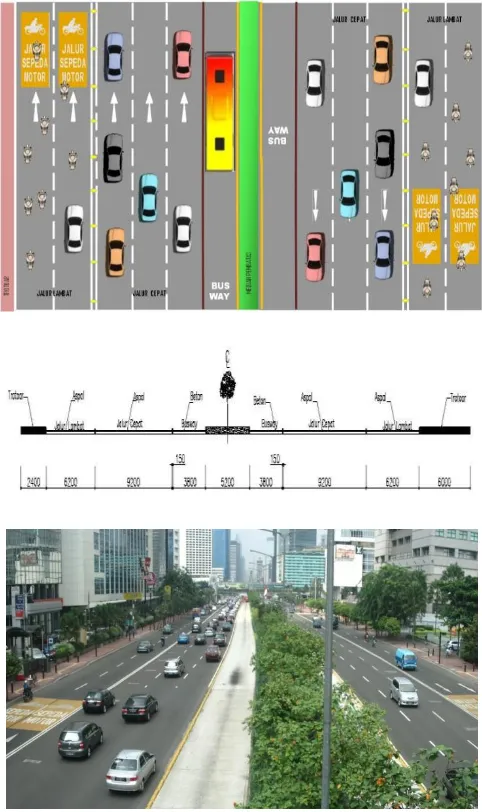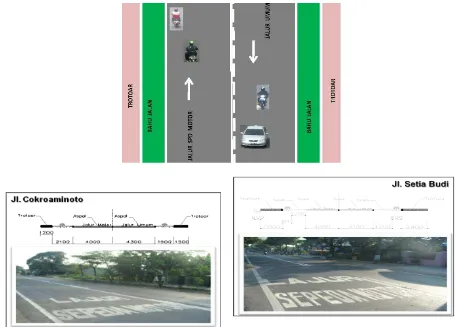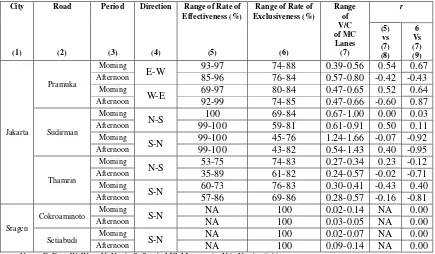The Performance of Motorcycle Lanes in Jakarta and Sragen
Head of Sub Directorate of Traffic Safety Management Ministry of Transportation Jl. Merdeka Barat No.8, Jakata 10110, IndonesiaGrand Panglimo Polim No. 59, Jakarta Indonesia Setiabudi 2 Building, 6th Floor, Jl. H.R. Rasuna Said Kav. 62, Jakarta Indonesia pattern related to the city size. This is due to severe congestion as an impact of unsatisfactory public transport services and uncontrolled city development. Whilst improving the quality of public transport, city transport authority needs to manage motorcycle traffic, e.g. by implementing motorcycle lane. In this paper only motocycle lanes in Jakarta and Sragen will be evaluated in terms of rate of effectiveness and rate of exclusiveness. Unfortunately all of the motorcycle lanes operated in Indonesia (except the one in Surabaya-Madura Toll Bridge) are non-exclusive lanes and therefore tend to be ineffective.
Key Words:motorcycle lane, Indonesia, rate of effectiveness, rate of exclusiveness
1. INTRODUCTION
services, city transport authority needs to manage motorcycle traffic. One of the measure that has been carried out in Jakarta, Surabaya, Malang, Sragen, etc was by implementing motorcycle lane. In this paper only motocycle lanes in Jakarta (3 types of motorcycle lane) and Sragen (2 types of motorcycle lane) will be evaluated in terms of rate of effectiveness and rate of exclusiveness. Unfortunately all of the motorcycle lanes operated in Indonesia (except the one in Suramadu Toll Bridge connecting Surabaya in Java Island and Bangkalan in Madura Island) are non-exclusive lanes and therefore tend to be ineffective.
2. LITERATURE REVIEW
Lubis (2009) describes a mental map of growths and impacts of motorcycle as shown in Figure 1. He argued that in Indonesia the increase in motorcycle production, increase motorcycle ownership as this is the most affordable transport mode that can be used to support social-economic activity of the owner/ user. Whilst supported mobility for social economic activity effects economic grotwth and GRDP the ability to buy more motorcycle will be increased. However uncontrolled growth of motorcycle use has negative impact on traffic inefficient use of road space and therefore increase congestion), environment (increase air polution) and safety (increase possibility of accident). What probably missed in his diagram (but mentioned on his text) was the other reason for purchasing motorcycle. Besides the reason of affordability of motorcycle, lack of appropriate public transport services put the motorcyclists as captive users. Moreover, lack of control in city development grows traffic generators everywhere and therefore results in severe traffic congestion.
Figure 1 Mental Map of Growths and Impacts of Motorcycle (Lubis, 2009)
Motorcycles grow rapidly, leaving other modes of transport behind, as can be seen in Figure 2. It can be seen that number of registered motorcycles (Indonesian National Police, 2006) in Indonesia, grows rapidly, especially after 2000 in which severe congestion in metropolitan cities become unbarable to most of the road users. As a results, Putranto and Tantama found that in Surabaya, Bandung and Mataram the proportions of motorcycle in the general traffic were significantly higher than default values indicated in IHCM (1997) as indicated in Table 1.
Figure 2 Number of Registered Vehicle in Indonesia 1987-2005 (Indonesian National Police, 2006)
Table 1 Proportion of Motorcycle in General Traffic in 3 Cities in Indonesia (Putranto and Tantama, 2009)
City Population Proportion of Motorcycle (%)
IHCM (1997) Putranto & Tantama (2009)
Surabaya 2,902,507 32 67-77
Bandung 2,340,624 32 56-71
Mataram 356,141 45 72-81
In order to overcome the rapid growth of motorcycle, the Ministry of Transportation has several policies as indicated in Table 2.
Table 2 Indonesian Policy on Motorcycle Growth Management
Instrument Description
Transportation system Development of mass rapid transit
Safety Vehicle test, the use of standardized helmet, safety education, law enforcement
Fiscal Increase ownership tax, increase fuel price, road pricing, increase parking fee
Environment Implementation of emission and air quality standard, sustainable engine and fuel technology,
Traffic management Motorcycle lane, zero motorcycle parking and motorcycle use in certain areas, speed limit
Suporting policy Accident information system, vehicle registration and driving license sytem, police officers skills development
It can be seen that the implementation motorcycle lane in one of the measure adopted by Ministry of Transportation to manage the rapid growth of motorcycle ownership and use.
Therefore this paper is aimed to evaluate the effectivenss of this measure in Indonesian context.
3. LAYOUT AND CROSS SECTIONS OF OBSERVED MOTORCYCLE LANES
In this paper the observations in five motorcycle lanes (three in Jakarta, the capitol of Indonesia and two in Sragen, a small city in Central Java). The reason for the choice of observed motorcycle lanes were their difference in design and therefore difference in operational characteristics. Figure 3 shows the layout and cross section of Pramuka road, Jakarta. It has a physical seperator between the motorcycle lanes and the non-motorcycle lanes (fast lanes). However to allow motorcycles to travel to the oposite direction, a U-turn movement is allowed and therefore they will use the fast lane to complete their U-turn movement before return to the motorcycle lane. The motorcycle lane itself is a non-exclusive one because, other vehicles might use the lane to access roadside activities and therefore it is more appropriate to be called a frontage road.
Figure 3 Motorcycle Lanes of Pramuka Road, Jakarta
(fast lanes). However, no U-turn movement is allowed and therefore the motorcycle stays in the motorcycle lanes. As in Pramuka road, the motorcycle lane itself is a non-exclusive one because, other vehicles might use the lane to access roadside activities and therefore it is more appropriate to be called a frontage road.
Figure 4 Motorcycle Lanes in Sudirman Road, Jakarta
Figure 5 Motorcycle Lanes in Thamrin Road, Jakarta
Figure 6 One Way Motorcycle Lanes Combined with Oneway Opposite Mixed Traffic Lane in
Sragen
4. METHODOLOGY
In the selected motorcycle lanes, observation was made in a normal working day (either Tuesday, Wednesday or Thursday) in the morning peak hours and afternoon peak hours. As different characteristics of activity different peak hours periods were used. In Jakarta all afternoon peak hour periods were between 15.00 and 18.00. However the morning peak hours period was between 7.00 and 10.00 in Pramuka road (as it is not in the CBD and therefore the morning peak hours period is happened earlier) and was between 8.00 and 11.00 in both Sudirman and Thamrin (to cover both period of controlled and uncotrolled car occupancy). In small city like Sragen the peak pattern is significantly different. Although it was decided to conduct morning peak hour observation between 6.00 and 9.00, the real peak flow was only between 6.30 and 7.30 in which school. There was no clear pattern of afternoon peak hours period in Sragen and therefore 15.00 to 18.00 was chosen to be relatively comparable with Jakarta. Vehicles were classified into three types according to IHCM (1997), i.e. light vehicles, heavy vehicles and motorcycles.
In each observation period, a 15 minutes sub period was applied. In each sub period, the followings were observed:
Number of each type of vehicles in motorcycle lane
Number of each type of vehicles in non-motorcycle lane
Afterward the followings can be calculated:
Rate of effectiveness of the motorcycle lane, i.e. percentage of motorcycles flowing in the motorcycle lanes relative to the overall motorcycle traffic.
Rate of exclusivenss of the motorcycle lane, i.e. percentage of motorcycles flowing in the motorcycle lanes relative to the the general traffic in the motorcycle lanes.
V/C of the motorcycle lanes and non-motorcycle lanes.
Pearson correlation between rate of effectiveness and V/C of the motorcycle lanes.
Pearson correlation between rate of exclusiveness and V/C of the motorcycle lanes
5. RESULTS
Table 3 shows the summary of the results. The results consist of rate of effectiveness, rate of exclusiveness, V/C and pearson correlation (r) between rate of effectiveness and V/C and rate of exclusivness and V/C.
It can be seen that in Jakarta, the best range of rate of effectiveness occured in Sudirman road in which motorcycle lanes seperated physically with the non-motorcycle lanes and no U-turn was allowed. The worst range of rate of effectiveness occured in Thamrin road in which there was no physical separation between motorcycle lanes and non-motorcycle lanes. Results in Pramuka show that, the availability of median opening for U-turn encourage more use of non-motorcycle lanes by motorcyclists to complete their U-turn movement. Some of them even used the bus lane assigned for the Bas Rapid Transit (BRT) due to lack of law enforcement.
Table 3 Summary of the Results
There was no clear pattern of sign of Pearson correlation (r) between rate of effectiveness and V/C and between rate of exclusiveness and V/C. Therefore effectiveness and exclusiveness of motorcycle lane were not related to V/C but rely more to the motorcycle lane system and design. Furthermore, law enforcement is a must if the system and design of the motorcycle lane are easaly violated.
6. CONCLUDING REMARKS
Rapid growth of motorcycle ownership use in Indonesian cities should be controlled by several measures such as improvement of public transport services, transport demand management, etc. Different characteristics of the cities results in different requirement for motorcycle lane system and design. The provision of motorcycle lane to manage massive number of motorcycle traffics should only be temporary measure before more sustainable transport such as affrordable and reliable public transport services can be provided.
REFERENCES
Directorate General of Highways (1997). Indonesian Highway Capacity Manual. Ministry of Public Work
Lubis, H.A. (2009) Motorcycle Growths and Its Impacts to Urban Transportation, Proceeding
of Eastern Asia Society for Transportation Studies, Vol. 7.
